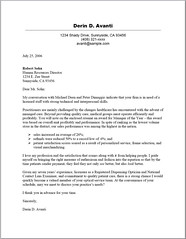 by Marlyn Damerick –
by Marlyn Damerick –
As a job hunter, you’ve come to understand the importance of a strong cover letter to persuade the employer to invite you for an interview. Now you sit down before a blank screen and prepare to draft it. What next?
A resume cover letter has five parts. Here they are and how to make the most of them.
1. Salutation
When you write”Dear Mr. [Employer],” make every effort to know who you’re writing to and how to spell the name. When you use name, you’re treating the manager like a person and showing that you have the initiative to go out and get the information. There are several ways to find out who you’re writing to. Look on the internet. Call the company and ask the receptionist. Make a trip to the library and ask the librarian to help you.
If all else fails, and you simply cannot get that name, start the letter with “Dear Hiring Manager” or “Dear Human Resources Manager.” Then follow with a sentence apologizing for not being able to find the name and go forward from there.
Never use “Dear Sir or Madam” or “To whom it may concern.” It suggests that you’re not interested enough to do any homework.
2. First paragraph — the connection
In the first paragraph, make a connection. Tell who you know at the company or how you know about the job. If the hiring manager’s brother-in-law told you about the job, say so.
It’s also important to start with something that will snag the attention of the employer. If you know someone connected to the company, that may be enough. If not, ask yourself how you yourself connect. “I have five years of experience in the [position] you’ve listed in [place you saw the ad].” Or “Robert Attorney, [company president's best friend], suggested that I contact you about a job in your [name of department].”
There’s no boilerplate here. You just have to think about what you bring to the job and how you can make a connection with the person doing the hiring. “I am writing to inquire about the position” is a snooze.
3. Second paragraph — your qualifications
In the second paragraph, show that you understand something about the employer’s challenges and how your skills can help solve them. You can find the information on the web or in the business section of the local newspaper. You can consider what challenges the industry as a whole is facing in the current economy, whether the market is growing or shrinking, regulatory environment, or whatever problem it would be your job to solve. Then explain how your qualifications make you fit to solve it.
4. Third paragraph — ask for the interview
In the third paragraph, reiterate your passion for the job and ask for an interview. This is the call to action, a necessary part of any sales letter. Include your contact information.
5. Postscript
Don’t miss the opportunity to use this valuable piece of letter real estate to emphasize your unique qualities. You might use it for your call to action. You might include an inspirational quote that fits the situation in some way. You might mention a scheduling issue, particularly if it shows that you are active and involved in your field, such as attendance at a relevant trade show or conference.
A well-crafted cover letter can move you from the “no thanks” stack to the “must interview” stack. Don’t let this opportunity get away.
For more information about writing an effective cover letter, get the free report Top Ten Secrets of the World’s Greatest Cover Letter.
Related posts:


